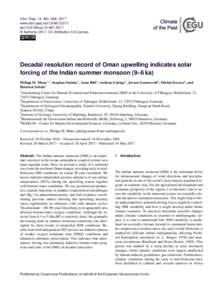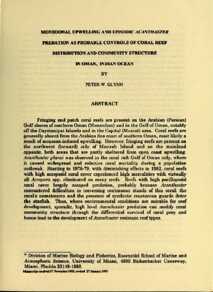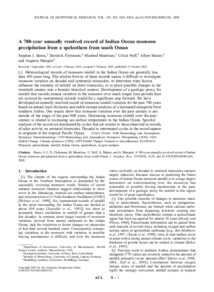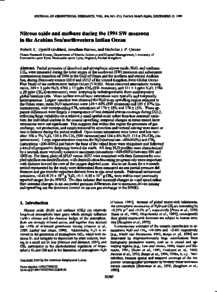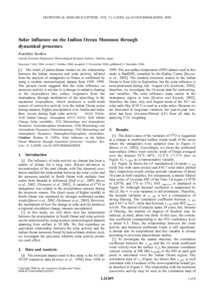Document
A solar (irradiance) trigger for millennial-scale abrupt changes in the Southwest monsoon?
Identifier
DOI: 10.1029/2004PA001031
Source
Paleoceanography. v. 19, 3, p. PA3015 1-18
Contributors
Altabet, Mark A. , Author
Wincze, Lauren., Author
Herbert, Timothy D. , Author
Murray, David W. , Author
Country
United States.
City
Washington
Publisher
the American Geophysical Union.
Gregorian
2004-09-01
Language
English
English abstract
Marine sedimentary records of the last glacial from tropical monsoon latitudes indicate climate fluctuations comparable to rapid changes in δ18O recorded in Greenland. Synchronizing two high-resolution sedimentary records from the Oman and Pakistan margins, we resolve millennial-scale reversals in sea surface temperature (SST) gradient (ΔSST) across the Arabian Sea which directly correspond with the majority of Dansgaard-Oeschger (D-O) events for the last 65 kyr. The relative amplitude of individual monsoon and D-O events appears comparable, suggesting coupled and at least hemispheric forcing. To explore this quasi-cyclic forcing, we compare alkenone-based geologic data with modern satellite-derived ΔSST estimates between sites. Interstadial conditions fall within the range of monsoons during the Holocene, but stadial conditions have no analogs. Following published associations between Eurasian Winter Snow Cover (EWSC) and monsoon rainfall, and El Niño/Southern Oscillation (ENSO) events and anomalous EWSC, we find a good correlation between the Southern Oscillation Index (SOI) and Arabian Sea ΔSST throughout the modern data set. An apparent 11-year cyclicity in the SOI reveals an association between the monsoon, SOI, and solar output variability. The SOI primarily tracks solar total irradiance, but the SOI monsoon linkage becomes nonlinear during excursions of the SOI associated with El Niño Events. Strong El Niños coincide precisely with minimum solar irradiance during the solar cycle, which we attribute to threshold behavior in tropical Pacific SSTs and associated trade wind strength. We propose that both short-term (interannual-decadal) and long-term (centennial-millennial) changes in solar output are consistent with records of ENSO variability, monsoon intensity, and D-O event timing.
ISSN
0883-8305
Category
Journal articles


